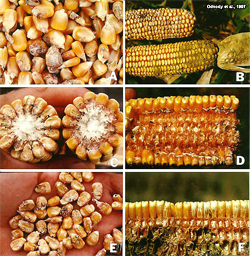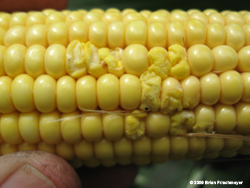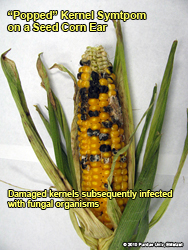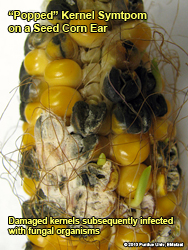Click image to view larger version.

Silk cut symptoms on a commercial corn
hybrid grown in Corpus Christi, Texas
[Odvody et al., 1997].

'Popped' kernel symptom before invasion by
fungi [photo courtesy Brian Frischmeyer].

"Popped" kernel symptoms on an inbred ear
of corn, with subsequent colonalization by
fungal organisms [photo courtesy Gene
Matzat].

"Popped" kernel symptoms on an inbred ear
of corn, with subsequent colonalization by
fungal organisms [photo courtesy Gene
Matzat].
August 2023
URL: http://www.kingcorn.org/news/timeless/SilkCut.html
Popped-Kernel and Silk-Cut Symptoms in Corn
R.L. (Bob) Nielsen
Professor Emeritus
Agronomy Dept., Purdue Univ.
West Lafayette, IN 47907-2054
Email address: rnielsen at purdue.edu
Twitter: @PurdueCornGuy
The "popped-kernel" symptom and the related "silk-cut" symptom are indeed corny oddities in that they rarely occur in commercial hybrids in Indiana but occasionally occur at significant levels in seed corn inbreds. Unfortunately, when the symptoms do occur, they predispose the affected kernels to attack by ear-rotting fungal organisms.
The Compendium of Corn Diseases (White, 1999) describes these two phenomenon quite well and I quote:
"Popped kernel and silk-cut, although common in breeders' nurseries, are rarely seen on commercial hybrids. It is assumed that this characteristic is inherited, and it is usually eliminated during the breeding and selection process. Popped kernel is an irregular break in the seed coat over the kernel crown. The kernel resembles a partially expanded popcorn kernel. This phenomenon is believed to result from irregular growth because it is most common during years with irregular rainfall, particularly when conditions are very hot and dry. Silk-cut is the embedment of silks in ruptured areas on tips of the kernel or occasionally in the sides of kernels between kernel rows. The exact cause of silk-cut is unknown, but it may be caused by irregular growth of the pericarp around unpollinated silks. Even on an ear that appears to be fully pollinated, as many as 10% of the ovules are not fertilized. Pollinated silks die and dry up, but silks attached to unpollinated ovules remain viable for an extended period of time. The viable silks push against the developing pericarp of kernels, causing the pericarp to rupture. Both popped kernel and silk-cut result in the rupture of the pericarp and allow infection by ear-rotting and saprophytic fungi."
There is not much research literature available that documents the cause(s) of the "popped-kernel" and "silk-cut" symptoms. Some research has documented that hybrids with short, loose husks tend to be more prone to the development of the "silk-cut" symptom (Farrar and Davis, 1991; Dowd, 1998). A report from Texas suggested that the "silk-cut" symptom occurs quite frequently in areas of south Texas prone to late-season drought stress (Odvody et al., 1997). Research in California and Hawaii suggested that "silk-cut" is associated with kernel pericarp damage from feeding activity by corn thrips (Frankliniella williamsi) on developing corn ears after pollination (Parsons and Munkvold, 2010). In that trial, insecticide applications significantly reduced the incidence of the "silk-cut" symptom.
Related Reading
Dowd, P.F., 1998. Involvement of arthropods in the establishment of mycotoxigenic fungi under field conditions. In: Sinha KK, Bhatnagar D, eds. Mycotoxins in Agriculture and Food Safety. New York, USA: Marcel Dekker, Inc, 307–350.
Farrar, J.J. and Davis, R.M., 1991. Relationships among ear morphology, western flower thrips, and Fusarium ear rot of corn. Phytopathology 81: 661–666.
Odvody, G.N., N. Spencer, and J. Remmers. 1997. A Description of Silk Cut, a Stress-Related Loss of Kernel Integrity in Preharvest Maize. Plant Disease 81 (5):439-444. http://apsjournals.apsnet.org/doi/pdf/10.1094/PDIS.1997.81.5.439 [URL accessed August 2023].
Parsons, M.W. and G.P. Munkvold. 2010. Relationships of immature and adult thrips with silk-cut, fusarium ear rot and fumonisin B1 contamination of maize in California and Hawaii. Plant Pathology 59:1099-1106. https://doi.org/10.1111/j.1365-3059.2010.02339.x [URL accessed August 2023].
White, Donald G. (ed.). 1999. Noninfectious or Abiotic Diseases. in Compendium of Corn Diseases (3rd Edition). APS Press, The American Phytopathological Society.